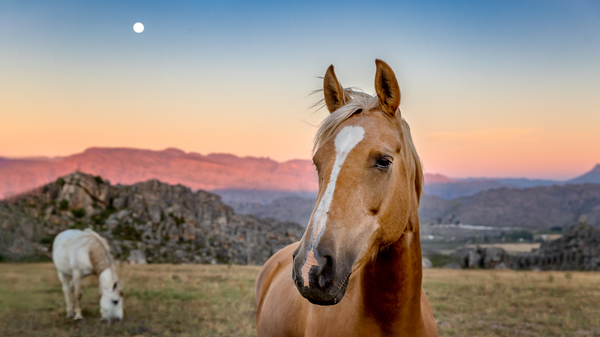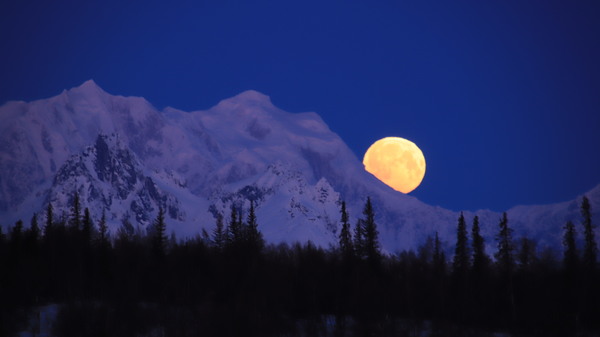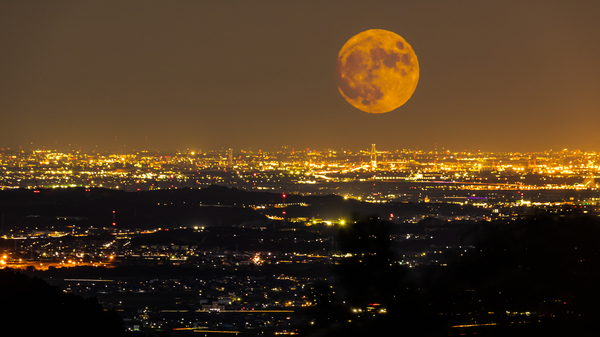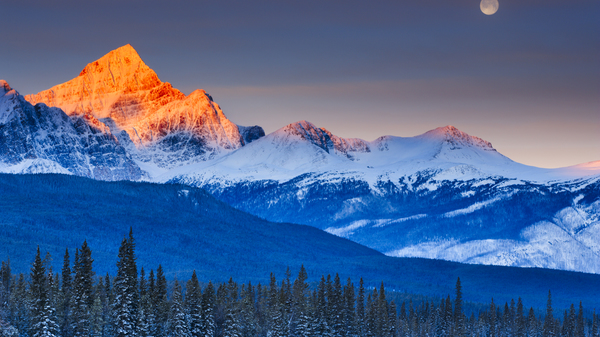Traditional Full Moon Names
Ancient cultures gave the Full Moons names like Flower Moon and Harvest Moon to track the months and seasons. These names are still in use today.

The June Full Moon is also known as the Horse Moon. Ancient cultures named the Full Moons from animals, plants, nature, and the seasons.
©iStockphoto.com/Natalie Goldsmith
Jan 2025: See the planets at their best
The 12 Full Moon Names and Meanings
The Full Moon has been integral to tracking the change of months and seasons since ancient times.
Although the most commonly used Full Moon names are English interpretations of Native American names, some are also Celtic, Anglo-Saxon, medieval English, and Neo-Pagan.
Many of the names come from the Colonial Americans adopting Native American names into their calendars, according to the Old Farmer’s Almanac.
January: Wolf Moon
The January Full Moon is often called the Wolf Moon from the howling of hungry wolves in the winter. This name is thought to have a Celtic and Old English origin, and that European settlers brought it to North America.
Other Celtic names include Stay Home Moon and Quiet Moon. Moon After Yule is an Anglo-Saxon version, referring to the pre-Christian Yule (or Juul) celebrations around the winter solstice. Native American names are Severe Moon and Center Moon.

A Full Moon setting over the snow-covered mountains of the Alaska Range, US.
©iStockphoto.com/R Lolli Morrow
February: Snow Moon
The Snow Moon in February is aptly named after abundant snowfall. Some North American tribes called it the Hungry Moon due to the scarce food sources during mid-winter, while others named it Bear Moon to refer to when bear cubs are born. Storm Moon, Ice Moon, and Snow Moon were common Celtic and Old English names.
March: Worm Moon
The last Full Moon of the winter season in March is the Worm Moon because of the earthworms that come out when the soil warms up. Native American tribes called it the Crow Moon for the crows coming back, Snow Crust Moon, and Sap and Sugar Moon for when the maple sap runs.
The Anglo-Saxons called it Lenten Moon after the Germanic Lenten for spring. The Celts called it the Wind Moon and Plough Moon. In Old English, it was known as the Death Moon and the Chaste Moon referring to the purity of the spring season.
April: Pink Moon
April has the Full Pink Moon, from the pink phlox wildflowers that bloom in North America in the early spring. The Native American names referred to the spring thaws and the return of growth, including Breaking Ice Moon and The Moon of the Red Grass Appearing.
Common names in Europe also referred to the budding and birth of spring: The Anglo-Saxons called it Egg Moon, the Celts had names like Budding Moon, New Shoots Moon, Seed Moon, and Growing Moon. A Neo-Pagan name is Awakening Moon.
The April Full Moon can also be the Paschal Moon, used to calculate the date for Easter.
Effects of the Paschal Moon on the Easter date

Both the April and May Full Moon have a name that refers to the budding spring.
©iStockphoto.com/kumikomini
May: Flower Moon
The Full Flower Moon in May describes all the flowers blooming in spring.
Native Americans called it Budding Moon, Egg Laying Moon, and Planting Moon. The Anglo-Saxon name is Milk Moon, while the Celtic and Old English names are Mothers’ Moon, Bright Moon, Hare Moon, and Grass Moon.
June: Strawberry Moon
June’s Full Moon is the Strawberry Moon as the little red berries ripen at this time and could be gathered by the Native American tribes. Other native names are Berries Ripen Moon, Green Corn Moon, and Hot Moon.
The Celtic names are Mead Moon, Horse Moon, Dyan Moon, and Rose Moon. Other English names are Flower Moon and Planting Moon.
July: Buck Moon
In July, the Full Moon is called Buck Moon to signify the new antlers that emerge on deer buck’s foreheads around this time. Other Native American tribes call it Salmon Moon, Raspberry Moon, and Thunder Moon.
In Celtic, this Moon was known as the Claiming Moon, Wyrt Moon, Herb Moon, and Mead Moon. The Anglo-Saxons called it the Hay Moon.
August: Sturgeon Moon
August has the Full Sturgeon Moon because of the large numbers of lake sturgeon in the Great Lakes and Lake Champlain. The fish was essential for Native American tribes in the area.
The Celts called it Dispute Moon and Lynx Moon, and the Anglo-Saxons the Grain Moon. Other English names include Corn Moon and Lightning Moon.

The 2020 Harvest Moon over Yokkaichi City, Japan. The Japanese tradition of observing the Harvest Moon is called Tsukimi.
©iStockphoto.com/petesphotography
September or October: Harvest Moon
Technically, the Harvest Moon is the Full Moon closest to the September equinox around September 22. The Harvest Moon is the only Full Moon name determined by the equinox rather than a month. Most years, it’s in September, but around every three years, it falls in October.
September: Corn Moon
In September, the Full Moon is the Corn Moon from the Native American tribes harvesting their corn. It can also be the Harvest Moon, which corresponds with the Anglo-Saxon name, while Celtic and Old English names are Wine Moon, Song Moon, and Barley Moon.
October: Hunter’s Moon
Traditionally, people in the Northern Hemisphere spent October preparing for the coming winter by hunting, slaughtering, and preserving meats, giving it its Anglo-Saxon name Hunter’s Moon. Every three years, the Hunter’s Moon is the Harvest Moon.
Native Americans named this Full Moon after fall, including Drying Rice Moon, Falling Leaves Moon, and Freezing Moon. The Celts used Seed Fall Moon to describe this. Also, the Pagan Blood Moon or Sanguine Moon is used for this Full Moon. However, this should not be confused with a total lunar eclipse, a Blood Moon.
November: Beaver Moon
The Full Moon in November is named after beavers who can be seen preparing for the winter. Native Americans also called it the Frost Moon and Freezing Moon.
In Celtic tradition, it is also called the Mourning Moon and the Darkest Depths Moon.

The December Full Moon is known as the Cold Moon. The Full Moon setting over Mount Edith Cavell in Jasper National Park, Canada.
©iStockphoto.com/Don White
December: Cold Moon
In December, winter begins for most people in the Northern Hemisphere. The December Full Moon is called the Cold Moon.
The Old English and Anglo-Saxon names are the Moon Before Yule or the Long Night Moon, referring to the longest night of the year in the Northern Hemisphere: the December solstice. The Celts called it the Oak Moon or the Full Cold Moon.
Note: Because Full Moons have been given names in different parts of the world with different seasons and cultures, there are several alternative names making this an extensive but not exhaustive list. Overlap between the months may also happen as the Full Moon name was used to track the whole lunar month.
Sleep, crime, and menstruation: how Full Moons affect humans
Southern Hemisphere Moon Names
The Full Moon names used today refer to the seasons in the Northern Hemisphere, so it doesn’t work to flip the names to fit the calendar in the Southern Hemisphere. As far as our research goes, Full Moon names are not common in Australia and New Zealand.
However, like the Native Americans, Māoris have their lunar calendar. It’s called the maramataka and starts in May. Each month has a name that refers to the season: Pipiri, Hongonui, Here-turi-kōkā, Mahuru, Whiringa-ā-nuku, Whiringa-ā-rangi, Hakihea, Kohi-tātea, Hui-tanguru, Poutū-te-rangi, Paenga-whāwhā, and Haratua.
Is the Moon upside-down in the other hemisphere?
Full Moon Names in Other Cultures
In Japan, the name tsukumi literally means “looking at the Moon” but is commonly used to name the tradition of viewing the Harvest Moon. Koreans call it chuseok, and it is similar to the Mid-Autumn Festival in China.
In Sri Lanka, the Full Moon is called Poya and each Moon has its own name and a dedicated holiday. Listed here in the order January-December: Duruthu Poya, Navam Poya, Madin Poya, Bak Poya, Vesak Poya, Poson Poya, Esala Poya, Nikini Poya, Binara Poya, Vap Poya, Ill Poya, and Unduvap Poya.
13th Full Moon in a Year
The time the Moon takes to orbit Earth is around 29.5 days and is called a lunar month, giving us about 12 Full Moons a year.
But because the lunar month is shorter than the month in a solar or tropical year, every two to three years, there is an extra Full Moon in a year. This Moon is known as a Blue Moon because it hasn’t got a name like the other 12 Full Moons of the year.